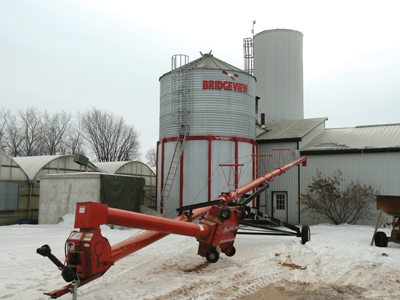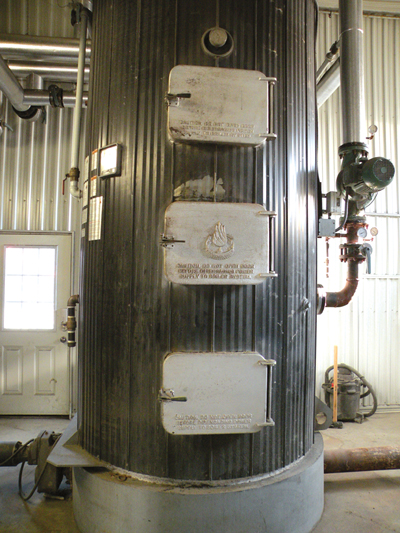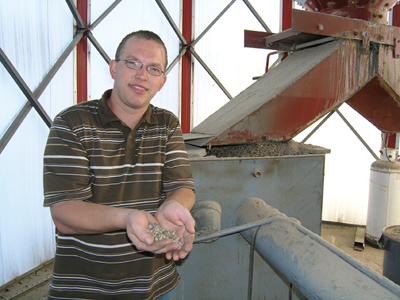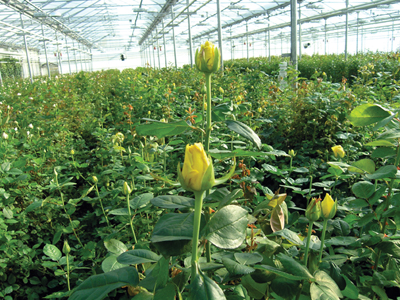
Warming up to Biomass
May 28, 2009
By
Heather Hager
Not everything worthwhile is easy. Take the switch to biomass. Although
often beneficial over the long term, it’s not always the easiest
process and may require a lot of experimenting and fine-tuning.
Not everything worthwhile is easy. Take the switch to biomass. Although often beneficial over the long term, it’s not always the easiest process and may require a lot of experimenting and fine-tuning. Brothers Scott and Ben Lindeboom of Lindy’s Flowers in Dunnville, ON, should know. They installed a Decker Brand multifuel boiler rated for 3.5 million BTUs into their family-run greenhouse in the spring of 2006. Since firing the boiler, they’ve tried several fuels and learned quite a bit about boiler mechanics.
 |
|
| The red grain auger is used to fill the grain bin (foreground) with wood pellets. The wood pellets are fed directly into the boiler via a gravity-fed auger system. Heat is stored in the heat storage tank behind the boiler building and used at night. Photos: Dave Harrison/GHC.
|
“The motivation behind the move to biomass was the rising energy prices,” explains Scott Lindeboom. “We went with the Decker boiler because of the automatic feed and automatic ash removal. A place our size could not afford to have someone standing around full time to keep the boiler going. We just don’t have the square footage to justify that.”
 |
|
| The Decker Brand multifuel boiler features automatic infeed through the back and automatic ash removal from the bottom right. Photo: Heather Hager. Advertisement
|
The system is automated via a touch-pad control panel, and the facility and controls are set up to allow the convenient installation of a second boiler. The system combines a gravity-fed fuel supply with a boiler, an economizer, and a heat storage tank. “The economizer takes a lot of dust out of the air and brings the stack temperature of the boiler down from about 500ºF (260ºC) to about 250ºF (120ºC),” says Lindeboom. The economizer uses the extra heat to warm the cold water before it enters the boiler, making the boiler more efficient. During the warmer months, the heat storage tank stores the heated water during the day when the greenhouse is warmed by the sun. The stored heat is used at night to keep warm air circulating and to vent the humidity, reducing mildew problems in the greenhouse and keeping the plants healthier.
The Lindebooms first started burning oat hulls in their Decker system “with pretty good success for the first couple of months.” However, changes to the manufacturer’s pellet recipe caused the fuel to plug the boiler. They then burned anthracite coal from Pennsylvania for about a year and a half. It flowed through the bin and into the auger quite well, burned clean with low sulphur and emissions, and kept the boiler fairly clean. The main drawback, however, was the amount of ash. “Because we had so much ash, we thought maybe there’s a better way,” explains Lindeboom.
Wood chips were not an option because they will not flow through the gravity-style grain bin without plugging. But the brothers found a mulch and pellet manufacturer located about 150 km away in Putnam, ON, so they made the switch to hardwood pellets. They have been burning wood pellets since May 2008. They are finding that each 40-tonne truckload produces about five wheelbarrows of wood ash. “We’ve been burning pellets since May and just pulled our first wagonload of ash out,” says Lindeboom. “We’re very happy with the wood pellets. Every different fuel requires different attention in certain areas, but so far with the wood pellets, it seems to be working quite well.”
The brothers estimate that they will burn 120 to 150 tonnes/month of wood pellets during the peak heating season. Their storage capacity provides enough pellets for about one and a half to two weeks during the peak season. During off-peak heating, the storage capacity provides three to four weeks of supply. There is the potential to build another storage bin to have extra pellets on site, says Lindeboom, but the need is not a pressing one because the supply seems to be reliable.
Costs and maintenance
Lindeboom estimates the investment as close to a quarter of a million dollars, factoring in all of the equipment, including the purchase of an auger to fill the storage bin, plus the building, concrete, engineering, and welders and electricians. “It was a costly endeavour to put up the boiler room. It pays off because you save money on gas of course, but it’s not like building greenhouses where it brings in more income. It’s a capital investment you make in order to maintain a certain energy cost instead of letting it go up.” He’s expecting about a five-year payback in energy savings.
 |
|
| Scott Lindeboom with the hardwood pellets the growers settled on after trying other fuels.
|
Then there are the unexpected costs. “The first boiler that we put in was defective,” says Lindeboom. “They replaced the boiler for free, but you have to get the welders and electricians in again. And we had to open the roof to the boiler room in order to get the crane to pull the old boiler out and put the new boiler in.” Although the daily maintenance only involves about 10 minutes of cleaning and checking for obstructions, Lindeboom says that he has been a bit frustrated with the amount of upkeep in terms of replacement parts, cleaners, and refractory.
When asked about the learning curve to run the system, Lindeboom says that it was quite steep. He likens it to buying a new car: When you hear a strange noise, at first you’re not sure whether it’s normal operating procedure or a reason to visit a mechanic. “In the background, you hear a bit of a bang—those are the cleaners inside the boiler cleaning the tubes out. We heard it on the first day and thought ‘okay, that’s the noise it makes,’ but when we hear them now, we can hear whether it’s working properly or not.”
“If you’re going to go into biomass, you almost have to become a bit of a boiler mechanic yourself or have someone around who wants to become a bit of a boiler engineer,” he says. “The only way you can learn is by being there when it breaks down to learn how to fix it or how to prevent a problem.” For example, when they switched to wood pellets, the auger began to clog and overload the motor. They figured out that they could prevent this problem by making the input hopper smaller. “When you become your own boiler mechanic, you learn how to tweak things to make it work properly.”
Gas vs. biomass
With the current infrastructure, the Lindebooms could install a second biomass boiler fairly easily. Still, they are waiting to see how the first winter goes with the wood pellets. “We’d love to put a second boiler in, but we want to get through a winter where it will actually run the entire winter without having to rely on gas heavily before we would even think of putting in a second one.”
 |
|
| The Lindebooms use biomass heating to keep 80,000 square feet of roses warm year-round.
|
And despite the 3.5 million BTU rating, the Lindebooms have yet to get more than about 2.8 million BTUs out of their system. “We have a 3.5 million BTU gas boiler up front, and it can easily heat this whole place and shut off during the day. If we do the calculations and compare apples to apples, we’re not getting the heat out of this boiler like we should be.”
Comparing natural gas to wood biomass, Lindeboom says that he likes the wood pellets because they have reduced costs below those for natural gas. He also mentions that they’re consistent, environmentally friendly, and carbon neutral. And he’s very interested in opportunities to earn carbon credits for burning biomass rather than fossil fuels to help offset some of the infrastructure costs. But he also likes the convenience of his old system. “Still, I think natural gas has got to be the nicest fuel to burn,” he says. “You turn it on, you turn it off, you walk away. Biomass, let’s face it, it is more labour intensive.”
“So, are we totally happy with the system? Well, today we are because it’s running. It has helped us to keep our costs down. But some days you just think, throw that thing in the scrap bin and turn the gas back on and just live with the extra costs.”
Print this page